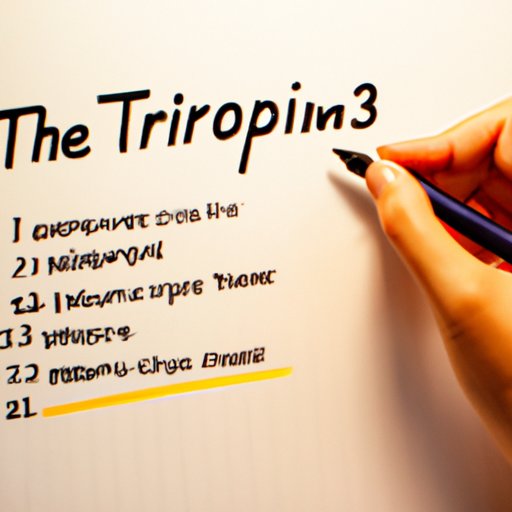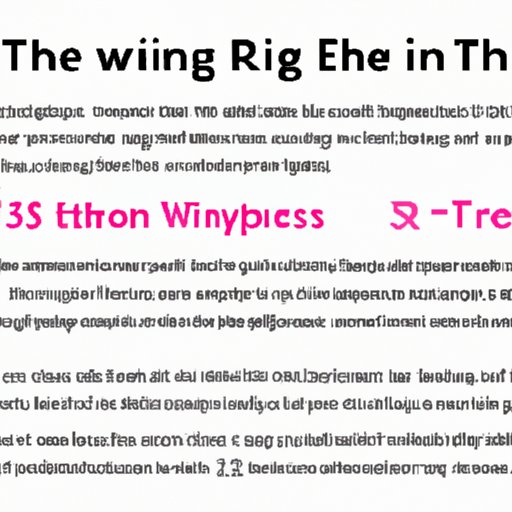Introduction
Writing in the third person is a form of storytelling commonly used in literature, academic writing, and journalism. But what exactly does it mean to write in the third person? This article will provide an overview of third person writing, exploring its different perspectives, and provide some tips for successful third person writing.
Exploring the Different Perspectives of Writing: What is Third Person?
When it comes to writing in the third person, the main difference between this point of view and the other two (first person and second person) is that it focuses on the subject being written about rather than the writer. In other words, third person writing is characterized by the use of pronouns such as “he”, “she”, “it” or “they” to refer to the subject of the writing.
Overview of 1st, 2nd, and 3rd Person Writing
The first person point of view is used when the writer is referring to themselves or their own experiences. It is often used in autobiographies and personal essays. The second person point of view is used when the writer is directly addressing the reader or speaking to them. It is much less common in formal writing and is typically found in instructions, advertisements, and other persuasive pieces. The third person point of view is used when the writer is talking about someone else or something else. It is the most commonly used point of view in formal writing.
Pros and Cons of 3rd Person Writing
The benefits of writing in the third person include the ability to maintain a more professional tone and a greater sense of objectivity. It also allows the writer to convey more information in a concise manner and to reach a broader audience. On the downside, writing in the third person can be more difficult to master and can sometimes come off as sounding too impersonal or distant.

A Guide to Writing in the Third Person
Now that you have a better understanding of what third person writing is all about, let’s take a look at some tips and tricks for writing in this style.
How to Use “He/She” and “It”
When using third person pronouns such as “he”, “she”, and “it”, make sure that they are used consistently throughout the piece. For example, if you begin with “he”, then continue to use “he” throughout the rest of the piece. If you start with “she”, then continue to use “she”. This will help to ensure that the reader knows who or what you are referring to.
Tips for Maintaining a Neutral Perspective
In order to maintain a neutral point of view while writing in the third person, it is important to avoid making assumptions or expressing opinions. Instead, stick to facts and let the reader draw their own conclusions. Additionally, try to remain objective and avoid injecting your own biases into the piece.

Understanding the Basics of Third Person Writing
In addition to following the tips outlined above, there are a few other aspects of third person writing that you should keep in mind.
Active vs. Passive Voice
When writing in the third person, it is important to remember to use active voice rather than passive voice. Active voice makes the writing clearer and more direct, whereas passive voice can make the writing sound dull and overly complicated.
Avoiding Biased Language
When writing in the third person, it is important to avoid using language that could be perceived as offensive or biased. This includes avoiding gender-specific pronouns such as “he” or “she” and using gender-neutral terms such as “they” instead.
How to Use Third Person Point of View in Your Writing
Now that you understand the basics of third person writing, let’s take a look at some tips for successfully incorporating this point of view into your writing.
Choosing the Right Words
When writing in the third person, it is important to choose your words carefully. Try to use language that is clear and concise and avoid using jargon or overly complex words. Additionally, make sure to use language that is appropriate for your audience.
Selecting Appropriate Tense
When writing in the third person, it is important to consider the tense of the sentence. For example, if you are writing about a past event, then you should use the past tense. Similarly, if you are writing about something that is happening in the present, then you should use the present tense.

Writing in Third Person: Examples and Tips
Now that you know the basics of third person writing, let’s take a look at some examples and tips for successful third person writing.
Examples of 3rd Person Writing
Here are some examples of sentences written in the third person:
- He went to the store.
- She was late for work.
- It was a beautiful day.
- They had a great time.
Tips for Successful Third Person Writing
- Be consistent: Make sure to use the same pronoun throughout the piece.
- Maintain a neutral perspective: Avoid injecting your own opinions into the piece.
- Choose your words wisely: Use language that is clear and concise.
- Use the correct tense: Make sure to use the appropriate tense for the sentence.
Conclusion
Writing in the third person can be a daunting task, but with practice and patience, it can become second nature. By understanding the different perspectives of writing, how to use “he/she” and “it”, maintaining a neutral perspective, choosing the right words, and selecting appropriate tense, you can become a master of third person writing.
Summary of Key Points
Writing in the third person is a form of storytelling commonly used in literature, academic writing, and journalism. It focuses on the subject being written about, rather than the writer. It is characterized by the use of pronouns such as “he”, “she”, “it” or “they” to refer to the subject of the writing. When writing in the third person, it is important to be consistent, maintain a neutral perspective, choose the right words, and select appropriate tense.
Final Thoughts on Third Person Writing
Third person writing can be tricky to master, but with practice and patience, you can become a pro.
(Note: Is this article not meeting your expectations? Do you have knowledge or insights to share? Unlock new opportunities and expand your reach by joining our authors team. Click Registration to join us and share your expertise with our readers.)
